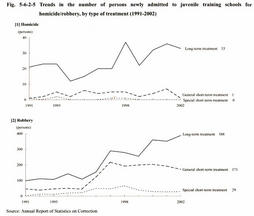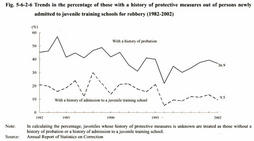| Previous Next Index Image Index Year Selection | |
|
|
2 Treatment in juvenile training schools (1) Overview Fig. 5-6-2-5 shows the trends in the number of persons newly admitted to juvenile training schools for homicide/robbery, by type of treatment. Although the number of those newly admitted for homicide is small, the number of those subject to long-term treatment has been generally on an increasing trend since 1995. For robbery, the number of those subject to long-term treatment has been on an upward trend since 1996, and it increased 3.6-fold from 1995 in 2002. This indicates an increase in the number of juveniles who have complex or serious problems and thus need long-term treatment.
(2) Juveniles with history of a protective measures Fig. 5-6-2-6 shows the percentage of those with a history of protective measures out of the persons newly admitted to juvenile training schools for robbery. The percentage of those with a history of probation or with a history of admission to a juvenile training school has been on a downward trend as a whole while continuing to increase and decrease, indicating the fact that there have been increasing cases in which juveniles without a history of protective measures suddenly commit robbery and admitted to a juvenile training school for the first offense.
Fig. 5-6-2-5 Trends in the number of persons newly admitted to juvenile training schools for homicide/robbery, by type of treatment (1991-2002) Fig. 5-6-2-6 Trends in the percentage of those with a history of protective measures out of persons newly admitted to juvenile training schools for robbery (1982-2002) (3) Trends in treatment in juvenile training schools In their operation, juvenile training schools have set treatment courses, etc. (see Part 4, Chapter 2, Section 4-1 for treatment courses, etc.) that meet the educational needs of individual juveniles, in consideration of their characteristics and problems, under the current legislation since June 1977, aiming to promote the individualization of treatment. As part of such activities, in September 1997, (i) operations were reviewed to further increase the flexibility of the term of treatment according to the needs of individual juveniles, and (ii) a new class of treatment course (G3) was established covering "those who need special programs for correction and rehabilitation due to the complexity and seriousness of their problems, resulting from the gravity of their delinquency." Furthermore, juvenile training schools have been enhancing their correctional education from the perspective of victims and working on guardians more actively, on the basis of recently increasing social requests for victim protection and support as well as the purpose of the amended Juvenile Law established in 2000. Education in juvenile training schools from the perspective of victims is introduced below, followed by an overview of treatment for G3 juveniles.
a Provision of education in juvenile training schools from the perspective of victims Guidance concerning the sense of atonement is cited as an example of education from the perspective of victims. Juvenile training schools implement guidance to facilitate juveniles who committed offenses without the ability to imagine or sympathize with the position and feeling of victims to reflect on the offenses and to cultivate the sense of atonement. For such guidance, various techniques are used including individual consultation, introspective guidance, role lettering (method through writing letters from both the victim's perspective and perpetrator's side) on the assumption of relationships with victims, and group discussion using notes written by victims as educational materials, and individual guidance and group guidance are combined as appropriate (see Section 4-1 of this Chapter ). For example, 52 juvenile training schools nationwide implement role lettering, 49 implement group discussion, and 33 implement introspective guidance (Source: Correction Bureau, Ministry of Justice).
In the case of juveniles who were involved in a serious offense, such as one that resulted in the death of a victim, they may have difficulty facing such reality when being provided with education from the perspective of the victims. Therefore, guidance has to be gradually proceeded while assessing the mental state and other factors of juveniles, and a careful approach from a long-term view is required in many cases. In order to arouse the sense of sincere atonement in juveniles, juvenile training schools need to encourage them to develop positive feelings about being alive in relation to both themselves and others as well as to realize the dignity of life. Such approach related to the very roots of a person's being is not expected to achieve an immediate effect by following a certain method of treatment, etc. However, various efforts have been made according to the characteristics and educational needs of individual juveniles, the environmental conditions of institutions, and so on. b Overview of treatment for G3 juveniles One of the policies for treatment of G3 juveniles is to provide treatment focusing on the most effective treatment in order to achieve the reform and social rehabilitation of individual juveniles. The term of treatment shall be set at for more than 2 years in principle, and juvenile training schools have been making thorough efforts to achieve the individualization of treatment and to increase the flexibility of the term of treatment. The contents of treatment focus on guidance to develop respect for life and guidance to cultivate a sense of atonement as well as therapeutic guidance to solve problems in predisposition. More specifically, (i) juvenile training schools actively include contents necessary to make juveniles recognize the preciousness of life and develop a rich sense of humanity in treatment, (ii) juvenile training schools actively provide guidance to cultivate a sense of atonement as part of life guidance in order to make juveniles deeply recognize the seriousness of their delinquencies and cultivate apologies for victims and their families, etc. in themselves, and (iii) juvenile training schools aims to solve the problems of juveniles and develop a feeling of sympathy and responsibility in them as well as consideration for others by using psychological treatment and other effective treatment techniques and through continuous consultation, counseling, and advice. For environments for juveniles after release, the implementation of focused guidance is provided, such as (iv) juvenile training schools aim at close cooperation with probation offices and actively give adjustment and guidance of relationships with guardians in sufficient consideration of feeling of people living in the place of next abode after release to achieve juveniles' smooth return to society.
Some juvenile training schools providing the living guidance course set a treatment course class for G3 juveniles. Out of the persons newly admitted to juvenile training schools, the number of G3 juveniles had remained under 10 until 2001: 1 was classified into G3 in 1997 (on and after October 6), 7 in 1998, 3 in 1999, 8 in 2000, and 3 in 2001. However, the number was 16 (13 males and 3 females) in 2002, the largest number to date (Source: Annual Report of Statistics on Correction). |

